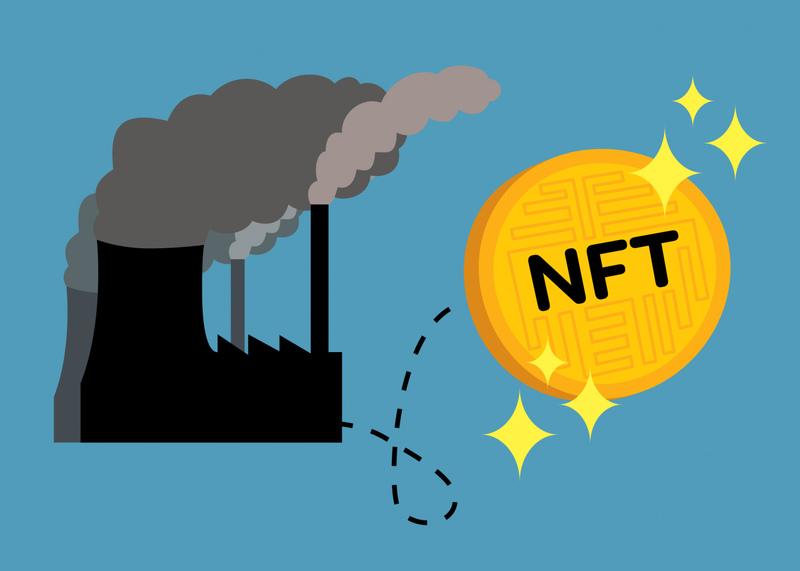The Environmental Impact of NFTs

Non-fungible tokens (NFTs) have ushered in a new digital ownership and artistic expression era. However, behind their innovation lies a pressing concern: the environmental impact of NFTs.
As these tokens gained popularity, they found a home on blockchain networks, which historically operated on the energy-intensive Proof of Work (PoW) consensus mechanism. Can the switch to a more environment-friendly Proof of Stake model reduce their energy consumption? Is it enough alone?
This article explores what is the environmental impact of NFTs and lays out the possible solutions for a greener future.
NFTs and the Environment Summarized
Familiarize yourself with the headlines that we discuss in this guide:
- NFTs, primarily on energy-intensive Proof of Work (PoW) blockchains, contribute significantly to carbon emissions and climate change due to their immense computational energy demands.
- Using devices like computers and smartphones to access NFTs leads to e-waste pollution. Therefore, they contaminate soil and water sources when users don’t dispose of them properly.
- Blockchain operations require powerful graphic processing units (GPUs). As a result, it could lead to resource depletion, habitat destruction, and deforestation in areas where minerals for these components are extracted.
- Ethereum’s transition to the energy-efficient Proof of Stake (PoS) consensus mechanism significantly reduces the environmental impact of NFTs.
- Emphasizing educational awareness, promoting green NFT initiatives, adopting renewable energy sources, and exploring innovative technologies pave the way for a greener future in the NFT space.
How NFTs Impact the Environment
NFTs operate on blockchain networks, which predominantly rely on the energy-intensive Proof of Work (PoW) consensus mechanism. PoW requires miners to solve complex mathematical puzzles using high computational power. Therefore, the massive computational load leads to an enormous energy expenditure, often powered by non-renewable energy sources.
This energy-intensive process directly contributes to the environmental crisis by increasing carbon emissions and exacerbating climate change.
Moreover, the carbon footprint of NFTs includes not only the energy used for minting (creating) NFTs but also the ongoing transactions and operations within the blockchain network. These emissions contribute to the greenhouse effect, accelerating global warming.
NFTs often involve creating and storing digital files. While digital art is eco-friendly, the devices used to access and interact with NFTs, such as computers, smartphones, and servers, contribute to electronic waste (e-waste) when people throw and replace them.
Improper disposal and recycling of e-waste can lead to environmental pollution, thus contaminating soil and water sources with hazardous materials and posing risks to ecosystems and human health.
Additionally, blockchain operations require significant hardware, especially powerful graphic processing units (GPUs). The production of these components necessitates the extraction of rare minerals and metals, contributing to resource depletion. Moreover, the environmental impact extends to the areas where these materials are extracted, leading to habitat destruction, soil degradation, and deforestation.
Ethereum’s Transition to Proof of Stake
Ethereum, one of the leading platforms for NFTs, underwent a fundamental change in September 2022. The network switched from PoW to Proof of Stake (PoS).
PoS drastically reduces energy consumption by eliminating the need for energy-intensive mining operations. Validators are chosen to create new blocks based on the number of tokens they hold and are willing to ‘stake’ as collateral. As a result, it significantly reduces the carbon footprint of transactions on the network and ameliorates the environmental impact of NFTs.
The transition to PoS presents a significant stride toward environmental sustainability. By minimizing energy consumption, Ethereum and other PoS-based networks dramatically decrease their carbon emissions.
Environmental Impact of NFTs – Possible Solutions
PoS and other initiatives can enhance the environmental impact of NFTs.
- Transition to Proof of Stake: Proof of Stake (PoS) consensus mechanisms are far more energy-efficient. They eliminate the intensive mining process by selecting validators based on the number of tokens they hold and are willing to stake as collateral. Therefore, it significantly curtails the carbon footprint of blockchain operations, aligning the industry with eco-friendly practices.
- Green NFT Initiatives: Embracing green hosting solutions and utilizing renewable energy sources for blockchain operations are crucial steps toward reducing the overall environmental impact of NFTs. Platforms adopting these initiatives mitigate carbon emissions and set industry standards for responsible environmental practices.
- Educational Awareness: Educational initiatives can highlight the importance of choosing eco-friendly NFT platforms, using renewable energy sources, and participating in carbon offset programs. As a result, stakeholders can make knowledgeable decisions that promote sustainability within the NFT ecosystem.
- Technological innovations and renewable energy: Integrating blockchain operations with renewable energy solutions, such as solar and wind power, reduces the reliance on non-renewable resources and significantly diminishes the carbon footprint of NFTs.
Where to Purchase Environmentally-Friendly NFTs
If you’re keen on acquiring NFTs while minimizing your environmental impact, various options are available. Several notable proof-of-stake blockchains include:
- Ethereum: Ethereum powers the renowned NFT marketplace OpenSea. It is also widely utilized for various applications, including token exchanges, NFTs, smart contracts, and decentralized applications (dApps),
- Solana: Solana’s blockchain supports various NFT marketplaces such as Magic Eden, Solanart, and Rabbit Hole, offering environmentally-conscious options for NFT enthusiasts.
- Algorand: Algorand backs Aorist, a climate-focused NFT blockchain tailored for artists, and is integrated with multiple NFT marketplaces. Its unique feature lies in its design, ensuring the blockchain never forks or splits into duplicate versions, enhancing the sustainability of NFT transactions.
- Cardano: Cardano hosts NFT marketplaces like CNFT and Galaxy of Art, providing eco-conscious users with an ideal platform for exploring and acquiring NFTs.
- Tezos: Tezos blockchain hosts several NFT marketplaces, including Rarible, which operates an NFT marketplace and supports artists in creating their NFTs. By choosing Tezos-based NFTs, you contribute to a more sustainable NFT ecosystem.
FAQs About the Environmental Impact of NFTs
Let’s address the common concerns regarding NFTs and climate.
What exactly is a carbon footprint?
A carbon footprint measures the total greenhouse gas emissions, primarily carbon dioxide, produced directly and indirectly by human activities or processes. It quantifies the environmental impact of these activities.
How do NFTs contribute to carbon footprints?
NFTs rely on energy-intensive Proof of Work blockchains for their creation and validation. The computational power required for these processes leads to significant energy consumption and, consequently, carbon emissions.
Can NFTs be environmentally friendly?
NFT production with a lower carbon footprint is possible through several strategies. That includes transitioning to eco-friendly blockchains, carbon offset programs, and reducing transaction frequency.
What is Proof of Stake, and how does it differ from Proof of Work?
Proof of Stake is an alternative consensus mechanism in blockchain technology. It selects validators based on the number of tokens they hold and are willing to “stake” as collateral. Hence, it eliminates the energy-intensive mining process found in Proof of Work.
Concluding the Environmental Impact of NFTs Guide
In conclusion, while NFTs have garnered attention for their creative and financial potential, addressing their environmental impact is crucial. By transitioning to more eco-friendly blockchains and adopting sustainable practices, the NFT community can minimize their carbon footprint and contribute to a greener digital future.
Please note that cryptocurrency investments carry inherent risks. Therefore, it’s essential to conduct thorough research and seek professional advice before engaging in any financial transactions.





